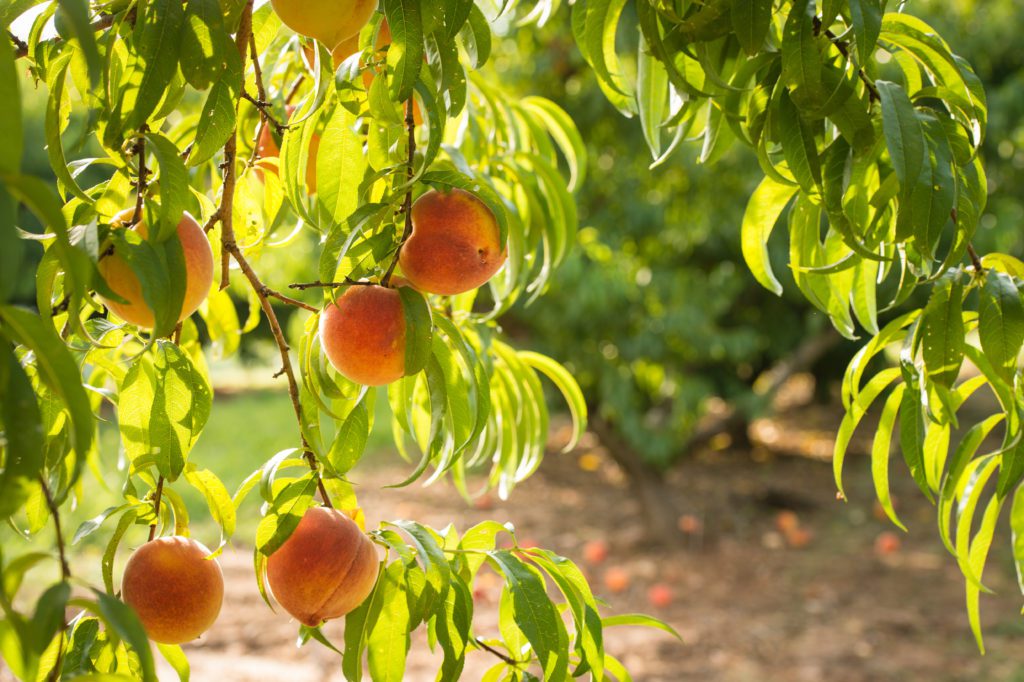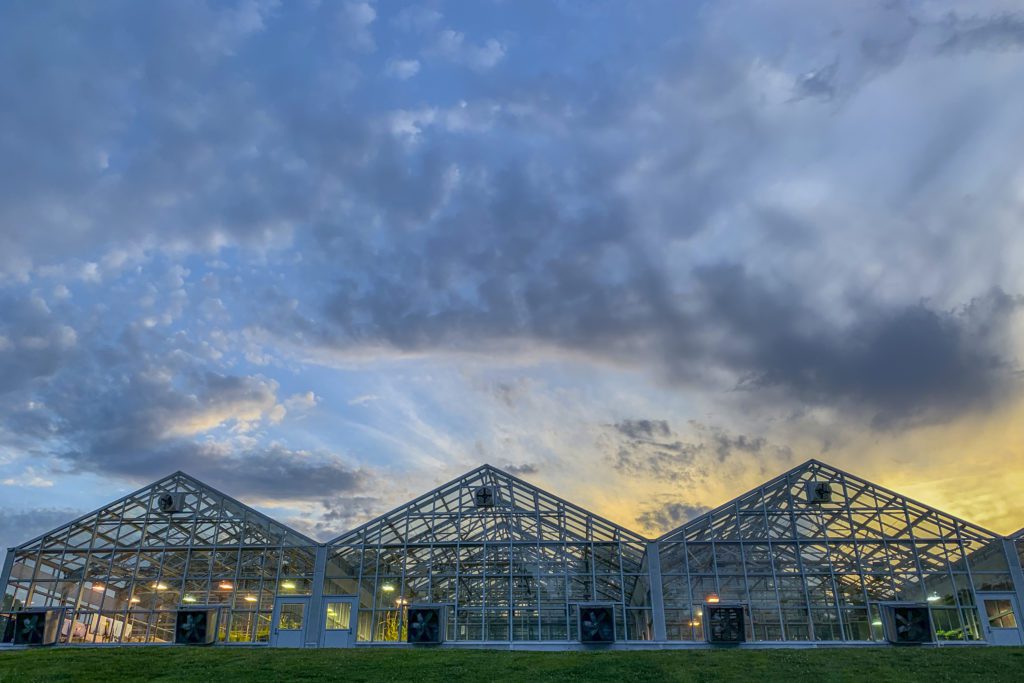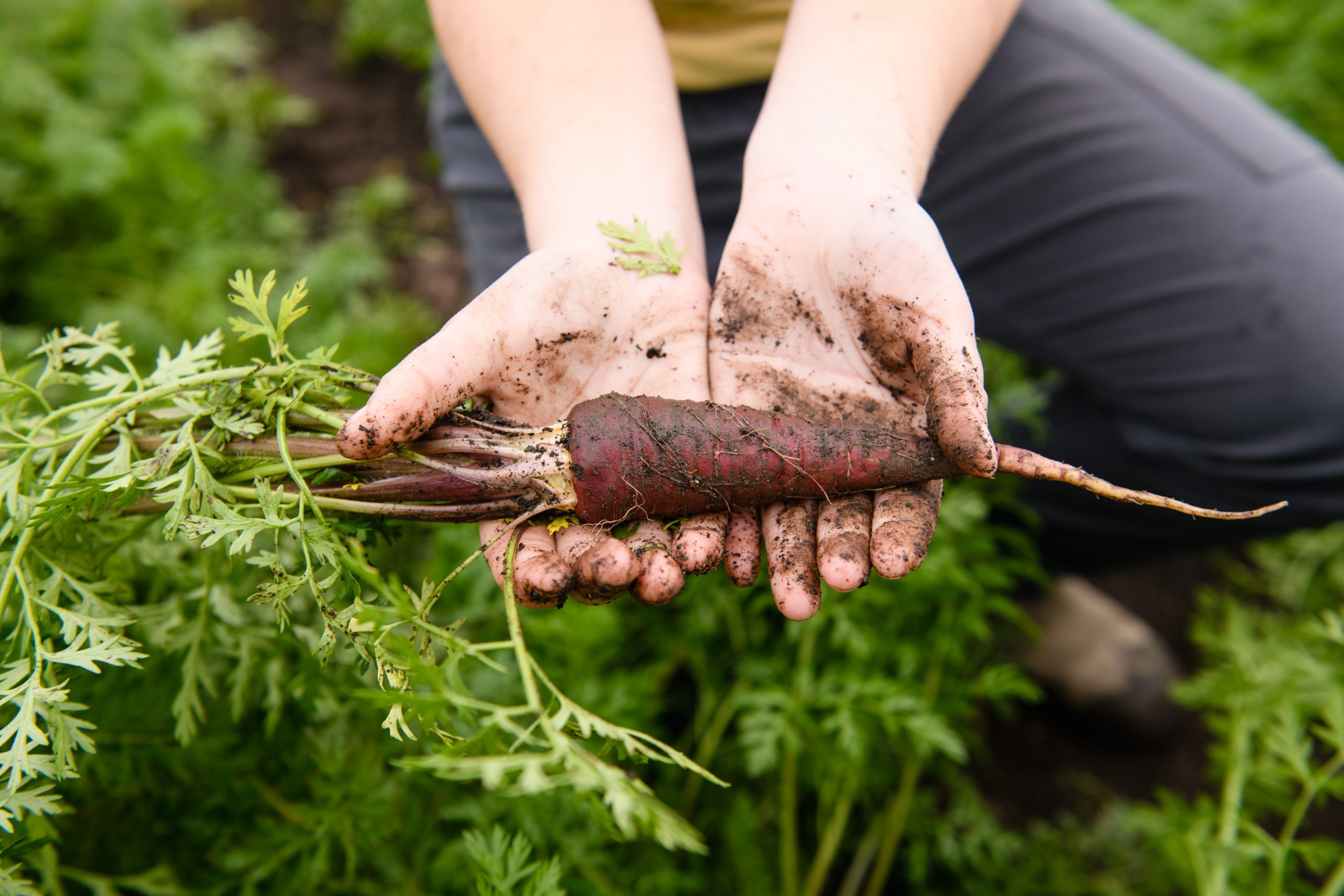Saving the Earth has Clemson scientists investigating ways to improve our dirt
Each Spring, Clemson’s 240-acre Musser Fruit Research Center erupts in brilliant pink blooms, but more than peaches will grow on the sprawling stretch of land and fruit trees along the shores of Lake Hartwell. Scientists are growing environmental and agricultural solutions there as well, studying how compost — culled from dining hall food waste and discarded peaches — might improve the soil for future peach crops.

The Clemson effort is twofold: First, it recycles and reuses an existing resource, diverting organic material from the landfill to the farm; second, it allows researchers to study viable alternatives to the synthetic fertilizers most often used to grow peaches, which are a major commodity in South Carolina.
“Compost adds organic matter that synthetic fertilizers do not,” explains Juan Carlos Melgar, an associate professor of pomology. “If we can improve the organic matter in soil, we improve fertility, reduce input costs, improve grower profits and support the environment.”
The weekly food waste delivery represents sustainability at work on a campus already focused on reducing its own carbon footprint. The research Clemson University is growing around these composting efforts foretells important gains for soil health, crop yields and farm profitability — not just in South Carolina but around the globe.
April marks Earth Month across the U.S., but year-round, Clemson is growing the science and study of sustainability through its study of soil health.
“Advances in soil health research will guide future management decisions that will lead to more resilient agriculture, a more stable food security and reduced environmental impacts,” says Paula Agudelo, associate dean for research and director of Clemson University Experiment Station for Clemson University’s College of Agriculture, Forestry and Life Sciences. “All of these are tied to our land-grant mission.”
Beneath the surface
Organic matter — decomposing plant or animal tissue — feeds the soil microbes that provide nitrogen for growing plants and sequester carbon. This matter can also improve water retention, reducing runoff and erosion.
Sustainability is at the heart of research projects like Melgar’s compost study and other studies at the Clemson Experiment Station, a collection of six Research and Education Centers (RECs) strategically located throughout the state based on distinct soil and climate regions. These facilities are part of a nationwide system of scientists working to improve quality of life for the people of South Carolina, the nation and the world.
“I think we can really improve the sustainability of our orchards,” Melgar says.
Soils
Essential to maintaining clean air and water, fruitful agricultural production, and healthy forests, soils are in a state of decline, with one-third of the world’s soils considered moderately to highly degraded. That is why, across the distinct soil and climate regions of South Carolina, Clemson University scientists are investigating sustainable land-management practices such as compositing, conservation tilling and cover-cropping.

One of the keys to a sustainable future for us all is the kind of soil health Melgar and his research pursue. While synthetic fertilizers have greatly improved crop yields globally in the past century, farm profitability in the United States remains stressed due to low commodity prices and rising costs for fertilizer, weed and pest control, and irrigation. Enhancing soil health and fertility can reduce these costs, boost production and improve overall environmental sustainability as the world grapples with how to feed a growing population.
According to data from the United Nations, Earth’s population is expected to increase by more than 2.3 billion by 2050, or nearly 30 percent. The U.S. is expected to add 50 million people over that timeframe. Available agricultural land, meanwhile, continues to decline.
In the past 60 years, the share of the U.S. land base used for agriculture declined 63 percent, according to the U.S. Department of Agriculture. Now, researchers are looking to the soil itself for a solution.
Soil that feeds
Soil is a living ecosystem of biomaterial and microorganisms essential to clean air and water, agricultural production and healthy forests. Soil regulates water flow. It sustains life for the plants and animals that feed off its nutrients. It filters pollutants. And it is an easily overlooked natural resource under decline. According to the United Nations’ Food and Agricultural Organization (FAO), one-third of the world’s soil is now moderately to highly degraded.
Clemson scientists are evaluating and fine-tuning land-management practices such as composting, conservation tilling and cover-cropping to improve soil fertility while minimizing the usage of synthetic fertilizer.
“My focus is to improve soil carbon,” says Rongzhong Ye, assistant professor of soil biogeochemistry at the Pee Dee Research and Education Center in Darlington.
Land Management Practices
Conservation tilling minimizes the frequency of loosening soil with farm equipment, or tilling. This can reduce carbon dioxide and greenhouse gas emissions, runoff, erosion, and fuel and labor costs.
Cover crops are planted to cover soil after the season’s harvest has been gathered. Typically legumes or cereal grains, cover crops can limit erosion and, when terminated before the next planting season, add nutrients back into the soil as they decompose.
“These fertilizers leach into soil and also release greenhouse gases into the air. We are going to increase nutrient-use efficiency by optimizing farm-management practices,” Ye says. “Cover cropping increases soil carbon content, which adds nutrients and improves soil structure to better retain water, support plant roots and reduce erosion.”
For cover crops to be effective, farmers must manage them as they manage their cash crops, he explains. That means choosing the right varieties and planting them and terminating them at certain dates, for example. Proper management is essential to making sustainable farming methods profitable.

This is a long-term investment in the conservation of soil health, Ye says. The soils in South Carolina’s Pee Dee Region, where Ye works in the northeastern corner of the state, are sandy, largely devoid of microbial life, and poor retainers of soil and nutrients. Still, the region has a sizable agriculture industry. The 7th Congressional District, which includes Florence and Darlington counties and other parts of the Pee Dee, produces nearly $600 million in agricultural products each year, according to the U.S. Department of Agriculture.
Protecting that land for future farmers requires a long-term commitment to soil health, Ye says: “Soil health is not just about improving the soil. It is about protecting what you have, even if what you have may not be ideal.”
Nature’s water filter
About 80 miles south of the Pee Dee REC at Clemson’s Belle W. Baruch Institute of Coastal Ecology and Forest Science in Georgetown, Alex Chow analyzes contaminants in the water.
“I am looking for watershed disturbance, how land management affects water quality and ecosystem health,” says Chow, professor of forestry and environmental conservation at the Baruch Institute. “Soil and water quality are closely connected.”
Chow’s findings can be used to design better land management practices for protecting drinking water sources. Hurricanes, increased land development and wildfires are impacting water quality.
“Soil health is not just about improving the soil. It is about protecting what you have, even if what you have may not be ideal.”
Rongzhong Ye, assistant professor of soil biogeochemistry at the Pee Dee Research and Education Center in Darlington
Scientists at the Baruch Institute have studied the coastal environment for more than 50 years, including the environmental impact of changing land-use patterns; coastal natural resource conservation; and forestry, water quality and watershed management. The research provides information to help public policy decision-makers manage growth issues so the state’s coastal environment can be preserved for future generations.
“Soil can filter water and affect soil and water chemistry,” Chow says. “Water can carry nutrients but also pollutants, depending on the sources or previous flow paths. Soil can retain certain nutrients and pollutants to prevent them from entering waterways.”
Chow’s research analyzes different soil amendments for micro-pollutant removal in wastewater irrigation. For example, farmers could add charcoal or other bio-materials to soil to serve as a filter to reduce excess nutrients or pollutants in agricultural drainage.
Additionally, his team is the first to study prescribed fire as a solution for improved drinking water quality. Prescribed fires are managed burns to reduce leaves and other natural detrital material on forest floors that can fuel wildfires. Chow’s research shows that prescribed fires can also reduce tea color-like dissolved organic matter entering waterways. Dissolved organic matter can react with disinfectants during drinking water treatment to form a variety of disinfection byproducts such as chloroform.
Better grasses, better growth
While the sandy and hard-clay soils typical of South Carolina are often detrimental to crop growth, the climate is favorable for year-round growing. Not enough landowners are taking advantage, says Matias Aguerre, assistant professor of animal and veterinary sciences. He is working to reintroduce native grasses and legumes as winter-season cover crops to help livestock owners improve their pastures and reduce reliance on hay and grains for feeding.
“Legumes can help reduce erosion and runoff, absorb nutrients and retain water,” Aguerre says. “Finding forages that use less water is going to be critical.”
Native grasses are drought tolerant and have extensive root structures that are good for carbon sequestration, he says. Unfortunately, they were replaced by European grasses that are hardier and better withstand constant grazing.
Aguerre and other Clemson scientists and Extension experts are working to introduce rotational grazing.
Native Grasses
Rotational grazing sections off pastures with movable fencing so only one section is grazed at a time. This allows pastures to recover when they are not being grazed. The practice not only keeps soil and pastures healthier, but it also could open the door for native grasses.
For rotational grazing to work, producers must know the nutritional values of the pastures to establish a healthy rotational schedule for both the fields and the animals. Forage quality and quantity directly affect animals’ weight, milk production and reproductive abilities. Over-grazing, on the other hand, can damage pastures. Aguerre and a team of Clemson researchers are developing an automated system using drones and ground robots to implement precision pasture management for producers.
Additionally, Aguerre is conducting field trials of native grasses and legumes at the Piedmont Research and Education Center near Clemson’s main campus. The tests will help him understand what mix of grasses and legumes works for the animals, the pastures and the livestock producers, while using fewer fertilizer inputs and water.
“We need to maximize the benefit to the animals and to the soil and the environment,” he says. “Land management is critical. We need to demonstrate to producers that we have the game plan to make this work.”
From sandy to healthy soil
Clemson scientists across the state are among those working on land management plans. At the Sandhill Research and Education Center in Columbia, Clemson is growing a mix of legumes, grasses and small grains as a winter cover crop to study improvements to water and nutrient retention.

“They don’t call it Sandhill for nothing. We are on sand, so fertilizer applications don’t stick. Our goal is to put more organic matter on the ground,” says Cory Heaton, an Extension assistant professor at the Sandhill REC. The study is in its third year, and Heaton says the cover crops are already suppressing weed growth to reduce herbicide applications.
“The cover crops are also helping to maintain more consistent soil temperature, which helps water retention,” he says.
Representatives from the U.S. Department of Agriculture, the Farm Service Agency and the Natural Resources Conservation Service have visited the fields and are working with Clemson to educate growers on the benefits of cover cropping.
“Growers are interested, and many are already doing it. They are trying to reduce input costs, and I don’t think anyone is more aware of the environment than our farmers,” Heaton says.
Better peaches — and beyond
Melgar has been testing compost on peach trees planted two years ago. Peach trees begin producing fruit after three years, so Melgar is hopeful to collect more detailed results on his compost study this summer.
“So far, we are seeing improved soil moisture and also nutrient uptake. Leaves we have sampled are higher in nutrients,” he says. “We are hopeful that turns into better tree health.”
As local municipalities and other organizations do more to limit food waste and close the food cycle, Melgar sees opportunities for cheap compost that could be used to add organic matter to agricultural land. Increasing organic matter improves nutrient and water retention and attracts microorganisms living in the soil. Microbe diversity in the soil can limit harmful pathogens that cause soilborne plant disease, Melgar says.
Increased organic matter brings about increased life for the soil, which is vital for long-term farm health and soil sustainability.
“The soil in our orchards has little life. There is very little organic matter,” Melgar says. “How can we increase life in the soil? We are working on it.”
Get in touch and we will connect you with the author or another expert.
Or email us at news@clemson.edu

